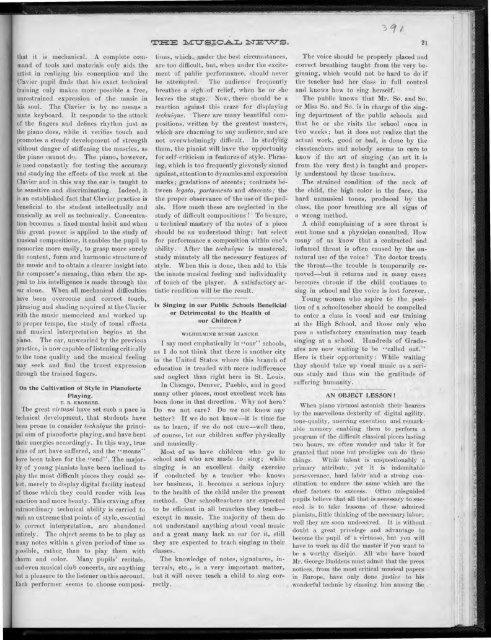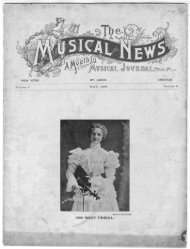You also want an ePaper? Increase the reach of your titles
YUMPU automatically turns print PDFs into web optimized ePapers that Google loves.
that it is mechanical. A complete commandof tools and materials only aid::l theartist <strong>in</strong> realiz<strong>in</strong>g his conception and theClavier pupil f<strong>in</strong>d:s that his exact technicaltra<strong>in</strong><strong>in</strong>g only makes more po sible a free,unrestra<strong>in</strong>ed expre.ssion of the music <strong>in</strong>his soul. The Clavier is by no meaus amute keyboard. It responds to the attackof the :f<strong>in</strong>gers and def<strong>in</strong>es rhythm just asthe piano does, while it verifies touch andpromotes a steady development of trengthwithout danger of stiffen<strong>in</strong>g the muscles, asthe piano cannot d~. The piano, however,is used constantly for test<strong>in</strong>g the accuracyand study<strong>in</strong>g the effects of the work at theClavier and <strong>in</strong> this way the ear is taught tobe sensitive and discrim<strong>in</strong>at<strong>in</strong>g. Indeed, itis an established fact that Clavier practice isbeneficial to the student <strong>in</strong>tellectually andmusically as well as technically. Concentrationbecomes a :fixed mental habit and whenthis great power is applied to the study ofmusical compositionEl, it ·enables the pupil tomemorize more easily, to grasp more surelythe content, form and harmonic structure ofthe music and to obta<strong>in</strong> a clearer <strong>in</strong>sight <strong>in</strong>tothe composer's mean<strong>in</strong>g, than when the appealto his <strong>in</strong>telligence is made through theear alone. When all mechanical difficultieshave been overcome and correct touch,phras<strong>in</strong>g and shad<strong>in</strong>g acquired at the Clavierwith the music memorized and worked upto proper temp_o, the ~tudy of tonal effectsand musical <strong>in</strong>terpretation begiJ,Js at thepiano. The ear, unwearied by the previouspractice, is now capable of listen<strong>in</strong>g criticallyto the tone quality and the musical feel<strong>in</strong>gmay seek and :f<strong>in</strong>d the truest expres~ionthrough the tra<strong>in</strong>ed f<strong>in</strong>gers.On the Cultivation of <strong>St</strong>yle <strong>in</strong> Pianoforte.Play<strong>in</strong>g.E. R. KROEGER.The gt·eat virtuosi have set such a pace <strong>in</strong>technical development, that students havebeen prone to consider technique the pr<strong>in</strong>cipalaim of pianoforte play<strong>in</strong>g, and have benttheir eneq~ies accord<strong>in</strong>gly. In this way, trueaims of art have suffered, and the "means"have been taken for the "end". The majorityof young pianists have been <strong>in</strong>cl<strong>in</strong>ed toplay the mo t difficult pieces they could select~merely to display digital facility <strong>in</strong>steadof. those which they could render with Jessexaction and more beauty. This crav<strong>in</strong>g afterextraord<strong>in</strong>ary technical ability is carried tob''llch an extreme that po<strong>in</strong>ts of Rtyle, essentialto correct <strong>in</strong>terpretation, are abandonedentirely. The object seems to be to play asmany notes with<strong>in</strong> a given pei·iod of time aspossible, rather. than to play them withcharm and color. lVIany pupils' recita.Js,and e,ven musical club concerts, are anyth<strong>in</strong>gbut a pleasure to the listener on this account.Each performer seem.· to choose composi-T:::S:E ~USJ:C..8..L NE~<strong>St</strong>ions,wh.icb, undet· the best circumstances,are too difficult, but, when under the excitementof public performance, should neverbe attempted. The audience frequentlybreathes a sigh of relief, when be or sheleaves the stage. Now, there should be n.reaction aga<strong>in</strong>!:-t this craze for display<strong>in</strong>gtechnique. There are many beautiful compositions,written by the greatest masters,which are charm<strong>in</strong>g to any audience, and arenot overwhelm<strong>in</strong>gly difficult. In studyi'n'gthem, the pianist will have the opportunityfor self-criticism <strong>in</strong> features of style. Phras<strong>in</strong>g,which is too frequently gievously s<strong>in</strong>nedaga<strong>in</strong>st, attention to dynamics and expressionmarks;gradations of accents; contrasts be'tween legato, portamento and staccato; thethe proper observance of the use of the pedals.How much these are neglected <strong>in</strong> thestudy of difficult compositions I To be sure,a technical mastery of the notes of a pieceshould be an understood th<strong>in</strong>g; but selectfor perfor'mance a composition with<strong>in</strong> one'sn.bility·. After the technique is mastered,study m<strong>in</strong>utely all the necessary features ofstyle. When this is done, then add to thisthe: <strong>in</strong>nate musical feel<strong>in</strong>g and <strong>in</strong>dividualityof touch of the player. A satisfactory artisticren.dition will be the result.Is S<strong>in</strong>g<strong>in</strong>g <strong>in</strong> our Public Schools Beneficialor Detrimental to the Health ofour Children ?WJLHELMINE RUNGE .JANOKE.I say most emphatically <strong>in</strong> "our" schools,as I do not th<strong>in</strong>k that there is another ci~y<strong>in</strong> the United <strong>St</strong>ates where this branch ofeducation is treacled with more <strong>in</strong>differenc~and neglect than right here <strong>in</strong> <strong>St</strong>. _ <strong>Louis</strong>.In Chicago, Denver, Pueblo, and <strong>in</strong> goodmany other places, most excellent work hasbeen done <strong>in</strong> thai direction. Why not here rDo we not. care? Do we not know anybetter? If we do not know-it is time forus to learn, if we do not care-well then,of course, let our children suffer physicallyand musically.Most of us have children who go toschool and who are made to s<strong>in</strong>g; whiles<strong>in</strong>g<strong>in</strong>g is an excellent daily exerciseif conducted by a teacher who knowsher bus<strong>in</strong>ess, it becomes a serious <strong>in</strong>juryto the health of the chi~d under the presentmethod. Our schoolteachers are -expectedto be efficient <strong>in</strong> all branches they teachexcept<strong>in</strong> music. The majority of them donot understand anyth<strong>in</strong>g about vocal musicand a great many lack an en.r . for it, stillthey are expected to teach s<strong>in</strong>g<strong>in</strong>g <strong>in</strong> theirclasses.The knowledge of notes, si.gnatures, <strong>in</strong>tervals,etc., is a very important matter,l>ut it will . never teach a child to s<strong>in</strong>g correctly.The voice should be properly placed undcorrect breath<strong>in</strong>g taught from the very beg<strong>in</strong>n<strong>in</strong>g,which would not be hard to 'do ifthe teacher had her class <strong>in</strong> full controland knows how to s<strong>in</strong>g herself.The public knows that Mr. So. and ~o.or Miss So. ::tnd So. is <strong>in</strong> charge of the s<strong>in</strong>g<strong>in</strong>gdepartment of the public schools andthat he or · she visits the school once <strong>in</strong>two weeks; but it does not realize that theactual work, good or bad, is done by th~classteachers and nobody seems . t~ ·care toknow if the art of s<strong>in</strong>g<strong>in</strong>g (an art it isfrom the very first) is taught and properlyunderstood by these teachers.The stra<strong>in</strong>ed condition of the neck ofthe child, the high color <strong>in</strong> the face, thehard unmusical tones, produced by theclass, the poor breath<strong>in</strong>g are all si'gns ofa wrong method.A child compla<strong>in</strong><strong>in</strong>g of ·a. sore throat issent home and a physician consulted. Howmany of us know that a contra.ctecl and<strong>in</strong>flamed throat is. often caused by the unnaturaluse of the voice? The doctor treatsthe throat--the trouble is t~mporarily · re-·moved-but it returns and <strong>in</strong> many cas~sbecor.nes chronic if the child cont<strong>in</strong>ues tos<strong>in</strong>g. <strong>in</strong> school and the voice is lost forey~r • .Young women who aspire to t.he posi-.tion of a schoolteacher should be compelledto enter a class <strong>in</strong> vocal and ear. tra<strong>in</strong><strong>in</strong>gat the High School, and those only w~opass a satisfactory ex~m<strong>in</strong>ation may te~chs<strong>in</strong>g<strong>in</strong>g at a school. Hnndreqs of Graduatesare now wait<strong>in</strong>g to be "called out."Here is their ot>portunity: While wait<strong>in</strong>gthey should take up vocal music as a seriousstudy and thns w<strong>in</strong> the gratitude ofsuffer<strong>in</strong>g buma~ity.AN OBJECT LESSON !When piano virtuosi astonish· their hearersby the marvellous dexterity of digital agility,tone-quality, unerr<strong>in</strong>g execution and remark- ,able memory enabl<strong>in</strong>g them to perform aprogram of the difficult classical pieces last<strong>in</strong>gtwo hours, we often wonder and tak~ it 'forgranted that none but prodigies can do the eth<strong>in</strong>gs. While talent is unquestionably aprimary attribute, yet it i<strong>in</strong>domitableperseverance, hard labor and a strong constitutionto endure the same which are thechief factm~s to uccess. Often misguided ·pupil believe that all that is necessary to succeed.is to take lessons of these admiredpianists, little th<strong>in</strong>k<strong>in</strong>g of the necessary labor;well they are soon undeceived. It is without ,doubt a great privelege and advantage tobecome the pupil oi a virtuoso, but you willhave to work as did the master if you want tobe a worthy disciple. All who have heardMr. George Buddeus must admit that the pressnotices, from the .most critical musical papers<strong>in</strong> Europe, have only done justice to his, wonderful technic by class<strong>in</strong>g. him among thie





